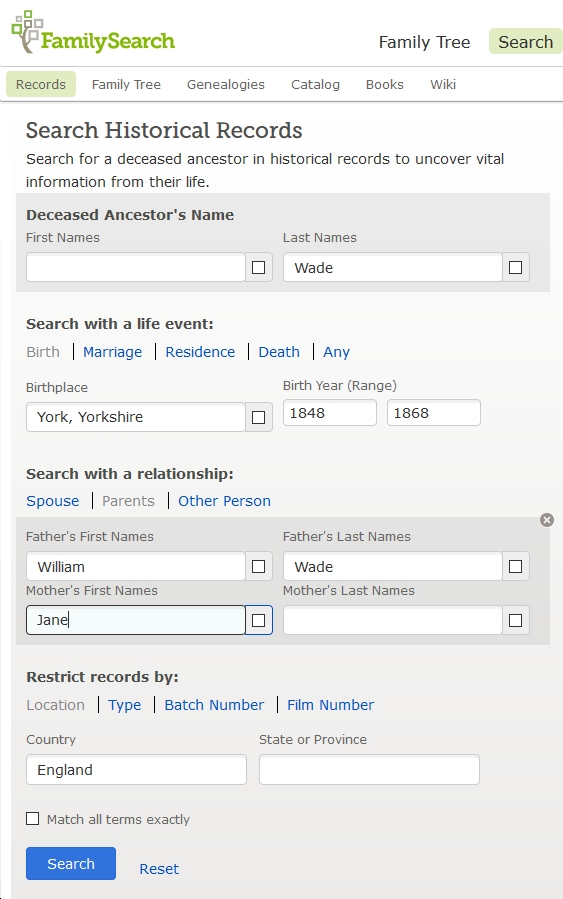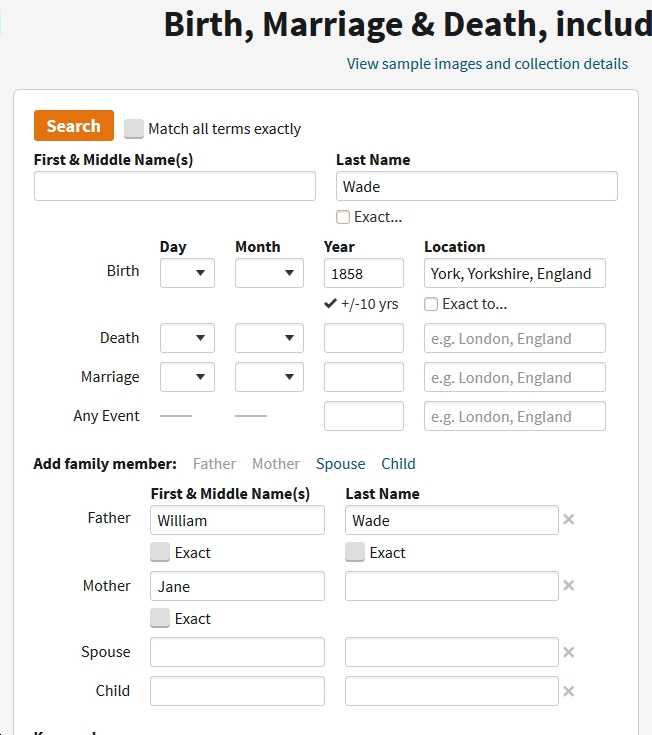Today’s post follows on from the last, in that the focus is on women. However, here we’re looking at the presence or absence of maiden names in official documentation, and their inclusion within naming patterns. (I’ve previously written more fully about Irish and English naming patterns, and these will also feature in my next post.)
Inclusion or absence of maiden names on civil birth certificates
Less experienced family historians often need help with understanding precisely what is meant by maiden name entries on civil birth registers and certificates, so we’ll start with this.
Without even buying a birth certificate there’s a lot of information freely available on the General Register Office Online Index, if you know how to decipher it. Here’s a classic entry to start with: the inclusion of Frances Mann’s mother’s maiden name (MMN) on the following entry tells us not only that her maiden name is Sword, but by extension also indicates that the former Miss Sword is now married to Mr Mann, and that he is the father.
| MANN, FRANCES | SWORD |
| GRO Reference: 1846 S Quarter in HUNSLET Volume 23 Page 287 |
Compare with this next entry. The absence of MMN (the ‘ – ‘) tells us that Albert Robinson was born out of wedlock. In other words, the MMN is the same as the child’s surname because the mother is not married.
| ROBINSON, ALBERT | – |
| GRO Reference: 1879 S Quarter in LEEDS Volume 09B Page 471 |
What about this one?
| TAYLOR, ALBERT | TAYLOR |
| GRO Reference: 1877 J Quarter in HUDDERSFIELD Volume 09A Page 386 |
Here we see that a MMN is given, but that it is the same as the child’s surname. This could mean two things: either the child is born out of wedlock, and the MMN is stated even though it is the same as the child’s surname; or the parents both had the same surname before marriage. In such a situation we would need to see the actual birth certificate (or marriage certificate) to be sure. If the parents are married the birth certificate would probably give the ‘Name, surname and maiden surname of mother’ as ‘[forename] Taylor, formerly Taylor‘; and the father’s details will of course be included.
Here’s another type of entry that less experienced researchers often have difficulty with: Under ‘Name, surname and maiden surname of mother’ you might see something like the following: ‘Margaret Robinson formerly Macanerny previously Baxter‘. This means the mother, Margaret Robinson, now married to Mr Robinson, was previously married to a Mr Macanerny. Before that, her maiden name was Baxter. It is the name Baxter that will be indicated online on the GRO Index, but to get that additional information you have to see the actual certificate:
| ROBINSON, JANE | BAXTER |
| GRO Reference: 1857 D Quarter in LEEDS Volume 09B Page 351 |
Understanding all of the above is great because it directs us to other life events and documents, or indeed indicates that such documents will not be found. Be aware though that an official document is only as true as the information provided by the informant. In the last example, the marriage between Margaret Baxter and Mr Macanerny was never dissolved, and twenty years of searching suggests she never actually ‘married’ Mr Robinson.
*****
We can now turn to ways in which people chose to include mothers’ maiden names when naming their children or indeed as a later choice of the individual him/herself.
Maiden names as middle names
It seems to have been during Victorian times that the fashion really developed for including the MMN as a child’s middle name. It did happen before this period, but seems to have increased in popularity amongst the middling and working classes at this time. Some families seem to have given the MMN only to the oldest son or possibly the oldest daughter; others gave the MMN as a middle name to all their children. It has nothing to do with legitimacy or otherwise of the child. In examples in my own tree, marriage dates clearly evidence that this was not in question. It is of course a bonus for the family historian, since it links without a shadow of a doubt the child to the mother’s lineage, and it’s particularly useful if the child was born prior to the introduction of civil registration in 1837. I have a 4x great aunt, for example, baptised in 1812 with the name Maria Thompson Wade, Thompson being the MMN. This is all the more helpful because the only record so far found for this baptism is a transcript, giving only the father’s name.
There are a few caveats to making use of this practice in our research though:
- On occasion the name passed down, although originating as a mother’s maiden name, may not be this specific mother’s maiden name. It may have been handed down by tradition in the male family, possibly originating some generations back, e.g. with a great grandmother. I have a possible example of this in one of my lines, and it’s a mystery I’ve not yet been able to solve: a child baptised in 1737 with the name George Chilvers Christian yet definitely the son of Christopher Christian and Barbara née Aylmer.
- The middle name may be mistranscribed as double-barrelled. A hyphen may even be adopted by choice of the individual in later life. So Thomas Beecroft Mann, surname Mann and MMN Beecroft, may possibly be indexed under the surname Mann or Beecroft-Mann, even though he considered his surname to be Mann.
- Here’s a tricky one that took me a while to work out: my 2x great aunt married a man named Allen Whitworth Schofield. As far as I can see, all of their children were registered with one or two forenames followed by Whitworth Schofield. Some of the children (the ones who emigrated to the US) adopted this as a double-barrelled name in adulthood. Others didn’t but transcribers often assume this to be the case. In fact the origin in this case does indeed stem from illegitimacy. Allen was registered in 1843 with the surname Schofield, and the absence of MMN on the GRO index indicates that his mother was unmarried. Four years later his mother marries Mr Whitworth and from that time Allen is recorded on censuses with the surname Whitworth. Although Allen eventually marries with the surname Schofield he continues to use Whitworth as a middle name, and to honour his stepfather he gives this as a middle name to his children.
Maiden names as first names
The use of a MMN as a first name may continue for several generations. When eventually we find the origin it’s a real bonus, confirming our research back to this point. The aforementioned Thomas Beecroft Mann named one of his sons ‘Beecroft’. I have also come across a Horner Ingham, also his uncle Horner Ingham, their name originating with the marriage of their grandmother/mother Ann Horner to James Ingham.
Maiden name as surname with father’s name as middle name
In contrast with the use of the mother’s maiden name as a middle name, when these names are reversed this always indicates illegitimacy. (Please note that I’m referring here to the historic situation, and not to present day surname naming practices which may be quite different.) Historically, a child born out of marriage was baptised with the surname of the mother. If, shortly after that, the parents marry it is quite normal for the father’s name to be inserted as a middle name. Although this is what happened in the Whitworth Schofield example above, the gap between Allen’s birth and his mother’s marriage (four years) suggests her new husband is stepfather rather than biological father to Allen. However, when my 3xG grandmother, Annabella, was baptised in 1816, the parish register recorded her parentage as ‘Martha Walker, a single woman of Micklefield‘. Four months later, Martha married James Noble, and in all documentation after that the child was known as Annabella Noble Walker. It is the short gap between baptism and marriage that indicates James is more likely in this case to be the actual father. In fact I can’t understand why he just didn’t step up a few months earlier! DNA matches have now confirmed he is definitely my ancestor.
I have seen one early 20th century example of this in which for delicate reasons I won’t go into the mother and father were not able to marry. The child was given the mother’s surname and had no contact with or knowledge of the father who did nevertheless, we think, pay for the child’s upkeep. However, the inclusion of the father’s surname as a middle name was part of the little paper trail that was left for some genealogist (Me!) to track him down more than 100 years later and permit an acknowledgement of him as biological father.
Formalising a middle MMN as a double barrelled surname for reasons of family pride
And finally, I have one example in my tree of the mother’s maiden name being adopted as a double-barrelled surname for reasons of pride in that individual’s notable maternal ancestry. In that example the person clearly wished to emphasise his connection to his maternal grandfather and also to his mother’s brother, a rather dashing and highly accomplished uncle, whose biography the nephew went on to write.
*****
Have you come across any other unusual uses of maiden names? Have you been able to draw upon a historic maiden name to verify your research? If you can add anything to the above please do share in the comments.

 To get started, we need to find Ann’s birth. We will use the GRO birth index and the following search criteria: surname Wade; forename Ann; female, born 1850 (exact); Registration District: York.
To get started, we need to find Ann’s birth. We will use the GRO birth index and the following search criteria: surname Wade; forename Ann; female, born 1850 (exact); Registration District: York.

 Our search in Ancestry starts with Search on the top menu bar, then selecting Birth, Marriage & Death. Search criteria here is: surname (forename left blank); year, plus/minus 10 years; birthplace; parents’ names.
Our search in Ancestry starts with Search on the top menu bar, then selecting Birth, Marriage & Death. Search criteria here is: surname (forename left blank); year, plus/minus 10 years; birthplace; parents’ names. Search criteria: surname; forename left blank; year (plus/minus 10 years); location. It is not possible to input parents’ names, therefore results are not filtered by this information – a disadvantage since this search returns 47 civil birth records and 145 baptisms. All the siblings are there, but I have to open and check each one to see if they are children of William Wade and Jane née Cass.
Search criteria: surname; forename left blank; year (plus/minus 10 years); location. It is not possible to input parents’ names, therefore results are not filtered by this information – a disadvantage since this search returns 47 civil birth records and 145 baptisms. All the siblings are there, but I have to open and check each one to see if they are children of William Wade and Jane née Cass.